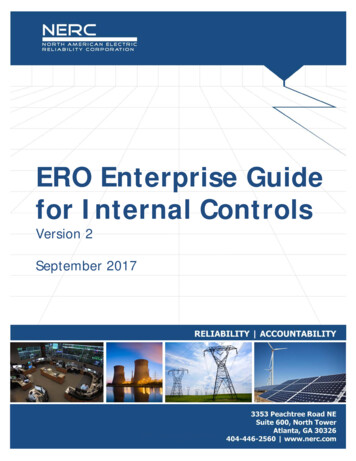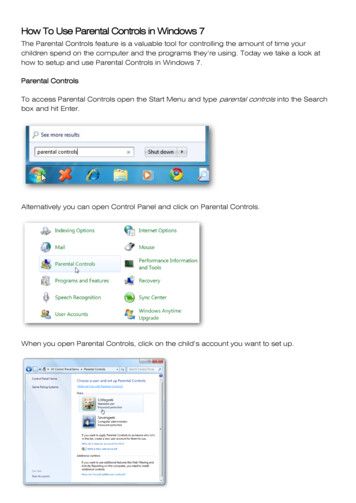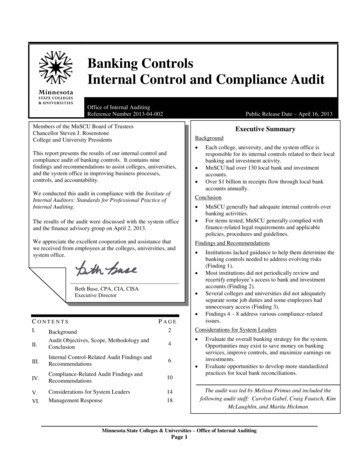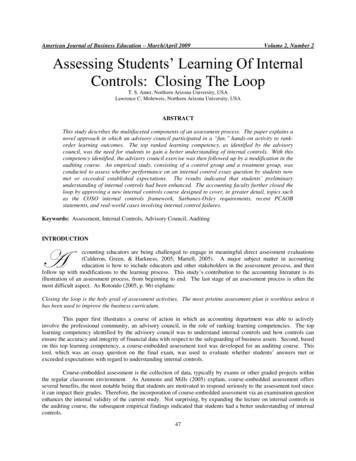
Transcription
ERO Enterprise Guidefor Internal ControlsVersion 2September 2017NERC Report Title Report DateI
Table of ContentsPreface . iiiIntroduction . ivRevision History . v1.0 Internal Controls and Compliance Monitoring .11.1 Understanding Internal Controls during CMEP Activities .22.0 Approach for Testing Internal Controls .32.1 Major Inputs .32.2 Evaluation of Design and Implementation .32.2.1 Internal Control Design .32.2.2 Using the Work of Others .42.2.3 Internal Control Implementation .42.2.4 Finalize Conclusions .52.2.5 Outcome.52.3 Reviews and Retests of Internal Controls .62.4 Internal Controls Evaluation .62.4.1 ICE Objective .62.4.2 ICE Timing and Selection of Internal Controls.63.0 Results Documentation .73.1 Sharing Results .73.2 Documentation Retention .74.0 References .8Appendix A: Considerations for Understanding Control Design .9Using Key Controls to Prioritize Testing .9Appendix B: Definitions . 10NERC ERO Enterprise Guide for Internal Controls Version 2 July 2017ii
PrefaceThe North American Electric Reliability Corporation (NERC) is a not-for-profit international regulatory authoritywhose mission is to assure the reliability and security of the bulk power system (BPS) in North America. NERCdevelops and enforces Reliability Standards; annually assesses seasonal and long‐term reliability; monitors theBPS through system awareness; and educates, trains, and certifies industry personnel. NERC’s area ofresponsibility spans the continental United States, Canada, and the northern portion of Baja California, Mexico.NERC is the Electric Reliability Organization (ERO) for North America, subject to oversight by the Federal EnergyRegulatory Commission (FERC) and governmental authorities in Canada. NERC’s jurisdiction includes users,owners, and operators of the BPS, which serves more than 334 million people.The North American BPS is divided into eight Regional Entity (RE) boundaries as shown in the map andcorresponding table below.The highlighted areas denote overlap as some load-serving entities participate in one Region while associated transmissionowners/operators participate in another.FRCCFlorida Reliability Coordinating CouncilMROMidwest Reliability OrganizationNPCCNortheast Power Coordinating CouncilRFReliabilityFirstSERCSERC Reliability CorporationSPP RESouthwest Power Pool Regional EntityTexas RETexas Reliability EntityWECCWestern Electricity Coordinating CouncilNERC ERO Enterprise Guide for Internal Controls Version 2 July 2017iii
IntroductionEffective internal controls support the reliability and security of the bulk power system (BPS) by identifying,assessing, and correcting issues; and their use can demonstrate reasonable assurance of compliance with NERCReliability Standards. This ERO Enterprise Guide for Internal Controls describes the Electric Reliability Organization(ERO) Enterprise approach for understanding and assessing internal controls as part of the overall Risk-BasedCompliance Oversight Framework (Framework). 1 This guide includes the ERO Enterprise approach for assessinginternal controls during compliance monitoring activities. This guide also assists Compliance EnforcementAuthorities (CEAs) in identifying and considering existing registered entity risk mitigation practices (commonlyreferred to as internal controls) in the development of the CEA’s Compliance Oversight Plan (COP) for thatparticular registered entity.The process for evaluating internal controls described herein applies to any type of registered entity regardless ofsize or function. As discussed, the internal controls evaluated relate to the inherent risk posed by a particularregistered entity and any associated NERC Reliability Standards. Therefore, the extent of an evaluation and theapplication of the evaluation criteria will vary in accordance with the level of inherent risk posed by the registeredentity.Even effectively designed and implemented internal controls cannot provide absolute assurance of compliancewith NERC Reliability Standards. The ERO Enterprise Guide for Internal Controls describes the approach CEAs useto assess the effectiveness of design and implementation of a registered entity’s internal controls. It also accountsfor the need to scale testing of internal controls to take into consideration the wide range of entity size and riskcharacteristics. The CEA develops a registered entity’s COP following the process described in the ERO EnterpriseGuide for Compliance Monitoring, 2 which considers results of internal control testing and other internal controlinformation identified during Compliance Monitoring and Enforcement Program (CMEP) activities. The COP isdynamic, and CEAs may make modifications based on changes to the registered entity inherent risk assessment(IRA), internal controls, and performance considerations.1Refer to the ERO Enterprise Overview of Risk-Based CMEP for additional information on the Risk-Based Compliance OversightFramework.2ERO Enterprise Guide for Compliance MonitoringNERC ERO Enterprise Guide for Internal Controls Version 2 July 2017iv
Revision HistoryDateDecember 2016September 2017Version NumberV1Comments Renamed the “ICE Guide” to the ERO EnterpriseGuide for Internal Controls Incorporated approach for ERO Enterprisereview of internal controls during CMEPactivities Revised and streamlined testing approach tofocus on testing internal control design andimplementation effectiveness Included references to the ERO Enterprise Guidefor Compliance Monitoring and content for COPdevelopment Updated appendices Appendix A contains revised definitions Appendix B contains additional detailsaround key controls Added series of principles to Section 1.0 Internal Controls and Compliance Monitoring Reordered Section 2.0 pertaining to thepotential role of ICE to facilitate a generaldiscussion about the value of evaluating internalcontrols before addressing Internal ControlsEvaluations Clarified process for sharing results in Section3.1V2NERC ERO Enterprise Guide for Internal Controls Version 2 July 2017v
1.0 Internal Controls and Compliance MonitoringThe ERO Enterprise follows professional auditing standards (e.g., Generally Accepted Government Audit Standards(GAGAS 3)) when conducting compliance audits and other CMEP activities. 4 Pursuant to such auditing standards,CEA staff will obtain an understanding of internal controls through inquiries, observations, inspection ofdocuments and records, review of other CEA staff reports, and direct tests. The nature and extent of proceduresCEA staff perform to obtain an understanding of internal controls may vary among compliance monitoringactivities based on compliance monitoring objectives, inherent risk, known or potential internal controldeficiencies, and the CEA staff’s knowledge about internal controls gained in prior compliance monitoringactivities.A registered entity cannot be found noncompliant based on the internal control design or implementation unlessthere is a noncompliance with a requirement of the NERC Reliability Standards. A sound business approach toincorporating effectively designed and implemented internal control improves operational and complianceperformance. Through evaluations, the CEA may take into account good governance practices of registeredentities that effectively manage risk to BPS reliability. In addition, the lessons learned from evaluating internalcontrols may encourage the adoption of such practices throughout the ERO Enterprise and industry.To fulfill the ERO Enterprise obligation to assure a highly reliable and secure BPS, the approach and processes forevaluating internal controls align with the following principles: Demonstrate reasonable assurance of a registered entity’s ability to mitigate reliability risk Inform the risk-based approach for developing registered entity oversight and monitoring Focus on repeatability and sustainability to ensure reliability and security rather than administration toassemble and archive evidenceEffective controls provide value and help registered entities self-identify and mitigate reliability risks and compliance issues, which could lead to the ability to self-logand correct lower-risk issues as Compliance Exceptions rather than navigating through the fullenforcement process; improve their reliability and security; inform the CEA’s development of the registered entity’s Compliance Oversight Plan (COP); and reduce the burden for audit preparation with a continuous monitoring process rather than a periodicevent associated with the registered entity’s preparation for compliance monitoring activity.As described in the ERO Enterprise Guide for Compliance Monitoring 5, the ERO Enterprise recognizes that internalcontrols cannot provide absolute assurance of compliance with Reliability Standards. CEAs may modify the nature,timing, or extent of compliance monitoring activities based on their understanding and evaluations of internalcontrols. When developing or updating a registered entity’s COP, internal controls may be used by the CEA toselect appropriate compliance monitoring tools under the CMEP.3GAGASNERC ROP, Section 12075ERO Enterprise Guide for Compliance Monitoring4NERC ERO Enterprise Guide for Internal Controls Version 2 July 20171
1.0 Internal Controls and Compliance Monitoring1.1 Understanding Internal Controls during CMEP ActivitiesAs part of the CMEP process, CEA staff will obtain an understanding of internal controls during CMEP activities aswell as during other registered entity interactions. The CEA’s understanding of internal controls during CMEPactivities, like a compliance audit, enable the CEA to make better-informed decisions around compliance and theregistered entity’s ability to sustain compliance and build reliability excellence. Additionally, a CEA’s review ofinternal controls during CMEP activities can inform future monitoring and the COP.After reviewing internal controls, the CEA should make decisions around the effectiveness of the design andimplementation that may change the nature, extent, and timing of compliance testing during fieldwork or future fieldwork (e.g.,audit fieldwork during a compliance audit); identify industry best practices, areas of concern, or recommendations; and refine the registered entity’s COP and future compliance monitoring.CEA staff should document decisions around the effectiveness of the controls. A registered entity’s COP shouldtake into consideration internal control information made available through CMEP activities like internal controlsevaluations (ICEs), audits, spot checks, self-certifications, or mitigating activities.NERC ERO Enterprise Guide for Internal Controls Version 2 July 20172
2.0 Approach for Testing Internal ControlsThe approach described within Section 2.0 applies to CEA assessments of internal controls during an ICE as wellas during compliance monitoring activities. The range of assessment activities CEAs perform will vary based uponthe registered entity’s inherent risk (e.g., size and characteristics), selection and prioritization of internal controlsfor assessment, etc. CEAs follow the approach described within this guide and use professional judgment to selectinternal controls to assess and draw conclusions on the effectiveness of a registered entity’s internal controls.2.1 Major InputsA primary input into selecting internal controls to test is the results of a registered entity’s IRA. During IRAdevelopment or refresh, the CEA identifies specific inherent risks and associated NERC Reliability Standards forthe registered entity. The IRA identified risks that are relevant to an ICE. Additional inputs that may help identifycontrols to test include the following: ERO Enterprise and Regional Risk Elements The registered entity COP developed per the ERO Enterprise Guide for Compliance Monitoring Other registered entity informationOther information may include an initial list of internal controls for risk identified by the registered entity andapplicable testing of those controls. CEAs may review some existing registered entity internal controls, focusingon reliability and security of the BPS and compliance with NERC Reliability Standards. CEAs do not expectregistered entities to create additional documentation or evidence for purposes of a CEA’s review of internalcontrols.2.2 Evaluation of Design and Implementation2.2.1 Internal Control DesignDesign effectiveness involves evaluating an internal control as it relates to meeting an objective. A control will beless effective if there are missing attributes or the existing design does not meet its established objective. Internalcontrols should be commensurate with a registered entity’s size and potential risk of the registered entity’soperations to the BPS.The CEA may obtain an understanding of internal control design through activities such as inquiries, observations,inspection of documents and records, work of others (e.g., internal audit departments), direct testing, etc. Whena registered entity provides internal control information, the CEA may decide to perform a walkthrough to betterunderstand and ensure an appropriate design. When evaluating internal control design, the CEA should useprofessional judgment to determine that it has sufficient and appropriate information to assess the effectivenessof the internal control design. 6Registered entities may use a variety of internal controls designed to provide reasonable assurance regarding theachievement of grid reliability, security of the BPS, and compliance with NERC Standards. Understanding theattributes or features of internal controls, including the types of internal controls (e.g., preventative, detective,corrective, or a combination of these) in place, helps the CEA better understand the internal control design andits linkage to NERC Reliability Standards objectives. Any internal control may fail, and a “perfect” internal controlis not possible. In some cases, a CEA may determine that one particularly strong internal control provides6The sufficient, appropriate evidence standard applies to the collection and review of information during an internal control review andevaluation, defined in GAGAS.NERC ERO Enterprise Guide for Internal Controls Version 2 July 20173
2.0 Approach for Testing Internal Controlsreasonable assurance of preventing or detecting noncompliance, but may determine in another case that a blendof internal controls is necessary.An internal control cannot be effective if it is not effectively designed. During the design review, if the CEA decidesthat the internal control design is not capable of achieving an established objective(s) and addressing related risks,the CEA may determine not to review the internal control implementation. The CEA should document its designreview, conclusions, and any feedback to the registered entity that it will share as described in Section 3.1.2.2.2 Using the Work of OthersMany registered entities employ an independent team to assess compliance with their risk management strategythat includes adherence to NERC Reliability Standards. An independent internal control review may be conductedby a specialist, a government entity (such as the Government Accountability Office or Nuclear RegulatoryCommission), a contractor who has been commissioned by the registered entity as a disinterested third party, oran internal department within the registered entity that is independent of the department performing ReliabilityStandards operations. If a registered entity seeks to have the CEA rely on the “work of others,” the CEA team mayreview the independence, capabilities, and competencies of the individuals performing the review and anyrelevant documentation related to the assessment itself for consideration in updating a COP.2.2.3 Internal Control ImplementationImplementation effectiveness includes an evaluation of whether the internal control is operating as designed. Theimplementation of an internal control is not effective if a properly designed control exists but does not operate asdesigned or if a person performing the control does not possess the necessary authority or qualifications toperform the control. 7When evaluating implementation effectiveness, the CEA will consider any supporting information thatdemonstrates implementation of the internal control. Based on the CEA’s understanding of the internal controls,the CEA should determine whether they provide reasonable assurance of compliance with the identified NERCReliability Standards. The CEA may have to review and test the implementation effectiveness for more than oneinternal control associated with a risk or NERC Reliability Standard.Assessm ent CriteriaThe CEA may use a binary effective/not effective method for assessing implementation effectiveness, or it mayuse a measured approach to assess internal control implementation. CEAs should have a documentedmethodology for assessing implementation, and this methodology may include, but is not limited to, thefollowing:7 The automation of internal controls Compensating and supporting internal controls Registered entity identification of key controls The level of available internal control documentation Peer review of key controls within the registered entity Feedback on control design processes Registered entity’s internal review and testing of existing internal controlsGAGASNERC ERO Enterprise Guide for Internal Controls Version 2 July 20174
2.0 Approach for Testing Internal Controls2.2.4 Finalize ConclusionsThe CEA should document conclusions around internal controls, including any control deficiencies noted duringthe assessment and provide documented feedback to the registered entity 8.Internal control design deficiencies may include, but are not limited to, the following: An internal control necessary to meet the objective is missing. An existing internal control is not properly designed so that even if the control operates as designed, thecontrol objective is not met.Implementation deficiencies may exist, but are not limited to, when a properly designed control does not operate as designed; and a person performing the control does not possess necessary authority or competence to perform thecontrol effectively.CEAs may consider the following when making decisions around the overall effectiveness of internal controls andany deficiencies identified:1. The likelihood that the deficiency will result in a violation of a NERC Reliability Standard: A deficiencymeans there is some likelihood a NERC Reliability Standard could be violated and the reliability of the BPScould be affected by the internal control failure. The greater the likelihood of violation, the greater theseverity of the internal control deficiency, and the more likely that the associated NERC ReliabilityStandards shall be evaluated as per the IRA outcomes.2. The effectiveness of other internal controls: The effective operation of other internal controls mayprevent or detect a risk to reliability. The presence of other controls may provide support for reducing theseverity of a deficiency and the associated monitoring of relevant NERC Reliability Standards.3. The aggregating effect of multiple deficiencies on NERC Reliability Standard compliance: A combinationof internal control deficiencies may adversely affect the registered entity’s ability to comply with one ormore NERC Reliability Standards, and affect the reliability of the BPS, depending on the objectives of theinternal controls.Key questions for finalizing conclusions should address the following: Do the internal controls mitigate the risks identified in the IRA? If the internal controls do not completely mitigate the risk, should correction be encouraged, rather thantesting of individual NERC Reliability Standards? How do the entity’s internal controls inform the COP for this registered entity?2.2.5 OutcomeThe evaluation outcome of internal controls includes the following: A list of the assessed internal controls and the decisions regarding design and implementationeffectiveness Internal control decisions that inform the registered entity’s COP and changes to the nature, extent, ortiming of assessing compliance with NERC Reliability StandardsAs the CEA prioritizes risk areas associated with any individual internal control deficiencies, focus must be kept ontailoring the COP for the registered entity. An internal control that the CEA determines to be deficient in some8GAGASNERC ERO Enterprise Guide for Internal Controls Version 2 July 20175
2.0 Approach for Testing Internal Controlsmanner does not mean a NERC Reliability Standard has been or will be violated. A deficient internal control maysimply result in the CEA modifying its compliance monitoring of the registered entity. The CEA shall prioritize theremaining risks based upon the entity’s internal controls. The CEA will adjust the COP to examine NERC ReliabilityStandards not effectively protected by an internal control.2.3 Reviews and Retests of Internal ControlsCEAs should review and revise assessments of internal controls as new, emerging, or unique information isobtained and as significant changes to the registered entity occur. As such, the CEA may review and retest internalcontrols previously evaluated to ensure the facts and circumstances remain the same and assessments are stillappropriate. Triggers for conducting a review may include, but are not limited to, changes in organizationalstructure, changes in internal control programs, changes in registered entity performance (e.g., misoperations,system events, or any new violations identified), and feedback from CEA staff or CMEP activities. For example,if a merger occurs between registered entities, the merger may impact internal control design and implementationthat would require additional testing to determine effectiveness.2.4 Internal Controls EvaluationAs described in the Framework, registered entities have an opportunity to: 1) provide, on a voluntary basis,information to their respective Regional Entity about their internal controls that address the risks applicable tothe entity and for identifying, assessing, and correcting noncompliance with Reliability Standards; and 2)demonstrate the effectiveness of such controls.2.4.1 ICE ObjectiveThe primary objective of ICE is to review internal controls to obtain reasonable assurance that their design andimplementation better ensure compliance with Reliability Standards. ICE supports more informed decisions oncompliance monitoring (i.e., develop COPs or modify nature, extent, and timing of testing of compliance),facilitates selection of tailored CMEP tools, and provides direction on continuous improvement for the registeredentity.The CEA is ultimately responsible for determining whether a registered entity has internal controls that providereasonable assurance of compliance with NERC Reliability Standards. The CEA makes this determination byunderstanding the BPS risks the registered entity is susceptible to and understanding how the registered entitymanages or mitigates those risks.2.4.2 ICE Timing and Selection of Internal ControlsThe ICE process involves collaboration and coordination between the CEA and a registered entity. CEAs typicallyconduct an ICE outside of a compliance monitoring activity. The CEA will work with the registered entity todetermine the timing of ICE activities. For example, an ICE may occur prior to a scheduled compliance audit tohelp refine the scope of the audit or inform testing of compliance with NERC Reliability Standards during the audit.As another example, an ICE may occur after a compliance audit if the registered entity and CEA have identifiedinternal controls that could inform future compliance monitoring and the COP.CEAs may select and prioritize internal controls to test their effectiveness. For example, CEAs may use the ERO orRE Risk Elements, Regional Risk Assessments, and IRA results to prioritize the testing of internal controls. CEAs canalso coordinate with a registered entity to determine which internal controls are available for testing, identifypossible key internal controls, or determine whether the registered entity has certain internal controls that maybe more mature and more appropriate for testing.ICE is a voluntary process, and registered entities, regardless of size, may participate in an ICE. The complexity ofinternal controls will vary across registered entities, and the CEA evaluation of such internal controls will beadjusted according to the registered entity’s BPS risk.NERC ERO Enterprise Guide for Internal Controls Version 2 July 20176
3.0 Results DocumentationCEAs should follow established documentation protocols, such as the NERC Rules of Procedure (ROP), and useprofessional judgment to determine documentation needs throughout the review of a registered entity’s internalcontrols during monitoring engagements as well as ICE. The extent of the documentation is directly linked to the1) nature and complexity of the internal controls reviewed; 2) procedures performed; and 3) methods andtechnologies used during the process. The more significant and complex these factors are, the greater and moredetailed the documentation should be.The CEA shall maintain documentation that clearly demonstrates its decisions around internal controls review aswell as ICE. Documentation includes all data and information obtained, reviewed, and tested.3.1 Sharing ResultsDuring internal control reviews, either as part of a monitoring engagement or ICE, the CEA will hold discussionswith registered entities to understand the design and implementation of internal controls and the effectivenessof such internal controls. CEAs should facilitate a collaborative dialogue with the registered entity throughout theinternal controls review. As needed, CEAs should work with the registered entity to ensure the CEAs have sufficientinformation to make decisions on the effectiveness of internal controls and to determine how they may influencechanges to the registered entity’s COP.The CEA should provide feedback to the registered entity on internal controls, such as recommendations forimprovements, discussions around best practices, areas of concerns, etc.The CEA will document and communicate its decisions and conclusions around internal controls and any COPupdates to the registered entity. The CEA will share changes to the COP no later than the notification periodsrequired by the NERC ROP for selected CMEP tools, and CEAs will provide additional information on compliancemonitoring activities in the annual ERO Enterprise CMEP Implementation Plan.3.2 Documentation RetentionThe CEA will retain all relevant documentation demonstrating the nature and extent of information reviewed, theprocedures performed, and conclusions reached. Documentation that should be retained includes (but may notbe limited to) analyses, memoranda, summaries of significant findings or issues, checklists, abs
CEA staff perform to obtain an understanding of internal controls may vary among compliance monitoring activities based on compliance monitoring objectives, inherent risk, known or potential internal control deficiencies, and the CEA staff's knowledge about internal controls gained in prior compliance monitoring activities.










